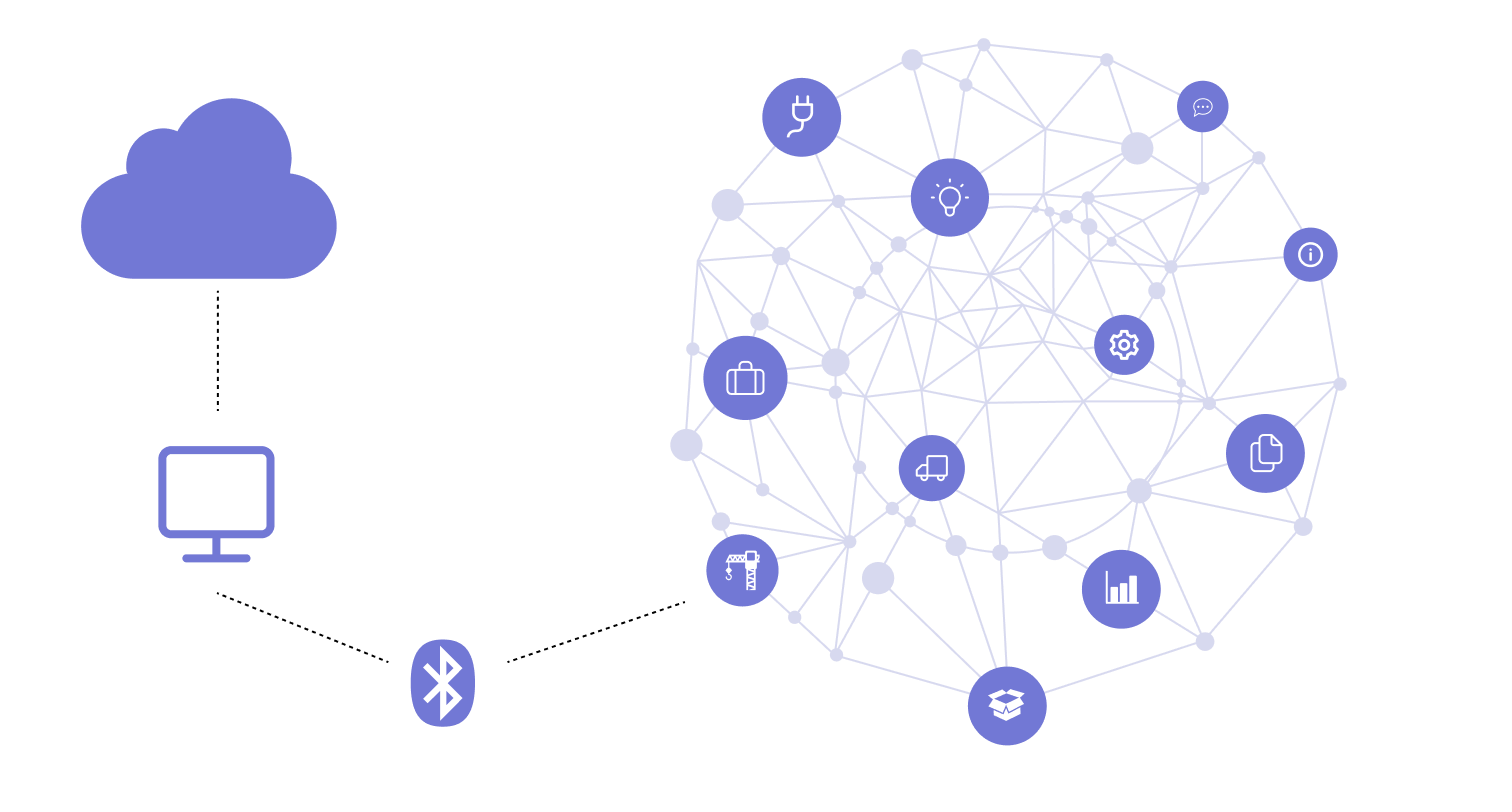Lighting systems are the most common area for mesh networking appliances. Complex lighting systems are used in warehouses, agricultural complexes, gardening, facilities, and other areas where smart lighting is required. Intelligent reaction within the IoT ecosystem allows light to be controlled and changed, for instance, when natural light changes. Each light source is a node in the network that can receive and send signals.
IoT mesh network: potential benefits and use cases
A distinct advantage of the Internet of Things (IoT) ecosystem is an ability for the data to travel continuously within it, enabling real-time control of the whole enterprise. With the growing adoption of smart devices, equipment, and people involved in enterprise processes, higher requirements are placed on networks to prevent critical data loss, danger cases, or downtimes. First, a communication network for the Internet of Things has to be reliable to continue operating if a part of the system fails, it must be fast to see the processes in real-time, and it needs to be scalable to adapt to changing conditions. Thanks to scalability and reliabillity potential first, IoT mesh network (meshnet) has taken an interest in the IoT ecosystem.
Today, we have positive use cases of utilizing the IoT mesh network for industrial proposes, and commercial and public sectors that leverage its potential for smart cities as well. In this article, we intend to help companies evaluate if the meshnet is likely to be considered for your IoT ecosystem development.

Benefits of an IoT mesh network on the Enterprise
A mesh network – is a way of organizing communication between infrastructure nodes, such as devices, end-points, and servers implying serial connections between them without central unit. Instead of an access point typical for a traditional network, all the nodes within a mesh network are connected to each other. This allows the system to create the most effective routes when transmitting the data, to circumvent connection limits, dead spots, or overloads that the traditional network can suffer from. Since there are plenty of routes between points, it naturally accelerates the overall speed of data transmission and reliability of the whole network.
These features of the IoT mesh network guarantee stunning benefits for the IoT ecosystem:
- Independence of the location. IoT ecosystems can be deployed in difficult-to-reach places and cover vast areas, which is also possible for IoT mesh network. Meshnet can operate properly, for instance, on the premises with lots of walls and corridors, manufacturings, or in the highlands. Additionally, these specifications allow for identifying the location of the object accurately and do not suffer from harsh weather conditions.
- Independence of overloading. New devices that are supposed to be connected to the mesh network, can’t overload it. On the contrary, every new node strengthens the signal. By transmitting signals to each other, the devices release the central node of faculty tasks.
- Intelligent reactions. The data collected by a sensor can be directly sent to actuators – specific devices that force the system to make the action (intelligent reaction), for instance, open the window when temperature increases, or stop the machine if it starts to fail. For devices, it is easier to communicate without a facilitator. It significantly automates the processes within an enterprise.
- Energy-saving nature. Since devices within meshnet do not output strong signals to reach the central unit, it requires fewer energy costs. Some mesh specifications, such as Bluetooth Low Energy (BLE) and Zigbee, can also help IoT devices save energy by keeping them in sleep mode when they are not in use. In particular, its low-energy nature leads to saving costs on battery changes, and power consumption as well as allowing the device to serve for a longer time. It is especially noticeable in expanding IoT with more devices involved.
- Potentially unlimited connections. Some meshes can support about 30+ thousand nodes, which is more than enough to make the whole factory smart. In practice, companies use several thousand nodes to build an IoT ecosystem in the enterprise. As we mentioned, the more devices that are connected, the stronger the signal is.
As we can see, such features make it possible to deploy the IoT mesh network both for small offices and large industrial enterprises. The main goal here – is to choose suitable mesh specifications to cover business goals.
Zigbee, Thread, Bluetooth, and Wi-Fi – choosing the IoT mesh network
The most widespread mesh networkings used in the IoT Ecosystem are Zigbee, Wi-Fi, BLE, and Thread. We could say that these networks are competing, although some of them can be combined to be used within one ecosystem. In general, companies should choose a network solution in accordance with their goal and be guided by the following causes:
- the nature of transmitted data
- physical conditions of the enterprise
- differences in approaches and metrics for different networks
- influence of factors of technical implementation of devices
- influence of environmental factors
- the influence of the network configuration
Need help?
Zigbee is a well-known first appeared mesh network that was created for home, lighting, and metering automation. Surely, it can be applied in various areas, although it loses in some parameters to other specifications. For instance, it has the lowest range and mediocre throughput, but it has an in-built optimization mechanism. Basically, It is advisable to use ZigBee in cases where it is necessary to integrate a new solution with an existing network based on this specification.
Compared to the other networks, Thread has the best network bandwidth and the lowest delays. This makes Thread the most stable network that provides a speed of data transmission of around 50 ms while Bluetooth shows the lowest speed of data transmission and stability. Thread also better copes with increasing loads. Thread can be called the universal solution for IoT mesh networks thanks to its best indicators of data transfer speed, minimal delays, and easy integration with IP networks and the Internet of Things ecosystem.
As it is clear from the naming that BLE mesh consumes much less energy than the other networks do. Unlike other specifications, Bluetooth Mesh utilizes managed flooding technology that allows to significantly decrease software requirements, which makes it easy to use Bluetooth on smartphones to see and control various processes within the IoT ecosystem. The distinctive feature is that Bluetooth Mesh has the maximum range among other networks. BLE is perfect for temporary or short-term connections. Although Bluetooth mesh can connect a significant amount of devices, the volume of data transmitted can cause delays. Under heavy loads, delays can reach 300 ms – a critical measure that is visible to the human eye.
Although Wi-Fi is the most widespread technology for internet connections around the globe, it can’t fully satisfy the needs of the IoT ecosystem when it comes to the Wi-Fi mesh network. Wi-Fi provides quick connections and enables the transmission of large amounts of heavy data, such as high-resolution images in real-time. However, it definitely needs an additional source of power that makes it suitable for large-scale devices with permanent Internet access. Although, if it is necessary to identify the location or proximity of the object, Bluetooth makes it much more accurate than Wi-Fi does.
In view of the foregoing, companies should consider various factors, such as the goals, ease of integration, scalability, and so on. Whatever the specification, the enterprise often needs to modernize their devices, update them or buy new systems to utilize a mesh network within the IoT ecosystem, or equip their assets with beacons.
Use cases
Since IoT mesh networks are created for non-ideal conditions, they can be implemented in premises with lots of walls and corridors, stand noise, and “mirrored” signals. Regardless, it is necessary to think over the location of every node to provide optimal connections. Despite this, the network can be expanded and strengthened at any moment by adding new nodes. As we mentioned, not all the IoT meshnets can transmit correctly extensive data all the time.


IoT monitoring of energy and utilities including power line monitoring and microgrid control for renewables helps with meter reading and controlling to optimize consumption while avoiding accidents. These systems are often deployed in difficult-to-reach spaces, that bring no issues for IoT mesh network.

As engineers and developers continue to push for lower energy designs and energy harvesting, more devices and applications may end up benefiting from amazingly long battery life. Warehouses, shops, offices, or residential buildings of various configurations can be easily equipped with mesh IoT.

Bluetooth mesh networking enables smooth communication between the devices and sensors that are located far from each other without applying routers or wires. It makes it much easier to send various data within manufacturing, for instance, from robot to control panel. Companies can implement various IoT mesh solutions also for monitoring assets within the enterprise, installing industrial automation sensors, and monitoring various conditions, such as temperature, humidity, pressure, etc.

All previous cases can be used city-wide. To actualize it, different devices have to be sorted by clusters. Here it is convenient to deploy smart street lighting, air pollution monitoring, or garbage collection. Since the city-scale deployment is affected by weather conditions, the network has to adapt to changing signal spread. Devices connected to the mesh networks automatically choose the optimal routing.
As we can see, the potential of using mesh networks is almost infinite. They can be entrusted with significant projects without risk of data loss because the mesh network continues to transfer data without internet access, or power outage.
IoT mesh network cybersecurity
A significant advantage for security is the possibility to disable the node without any harm to the system in case of hacking. This fact made the mesh network a cybersecurity tool. However, mesh networks have their own ways to protect the transferring data. Encryption and authentication are used not only on the network level but also in applications that allow nodes to send only encrypted data that can be decrypted only via a separate application key. For instance, Bluetooth 5 supports encryption of all the messages with three types of keys that provide a high level of security. Also, companies that implement BLE mesh can also organize their secure upper-layer protocol.
Wrapping up
- IoT mesh networks are widespread enough because of their ability to function without Internet access and the creation of significant networks without overloadings.
- The obvious benefit of these networks is their power-consuming nature and high speed of data transmission. When it comes to measurements when the delay time is critical, it is better to choose Zigbee or Thread specification.
- IoT mesh networks can be utilized for difficult-to-reach spaces that make it real to be implemented in manufacturing, for utility monitoring, building automation, and so on.
- BLE is perfect for temporary or short-term connections. If the network is going to be used constantly, it is better not to send large amounts of data simultaneously. Thread has the best data transfer rates, minimal delays, and easy integration with IP networks. ZigBee is advisable to use in cases where it is necessary to integrate.
- Mesh networks can be a wonderful solution even for smart cities. The main issue – is to calculate if the network is capable of providing stable connectivity for all assets you want to involve. For choosing an appropriate network, companies can always refer to IoT consulting services.















